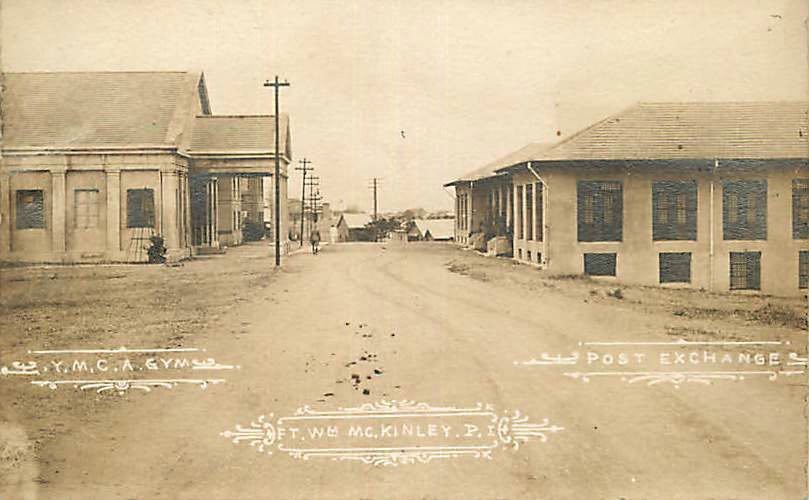#FlashbackFriday: The Exchange’s History in the Philippines

For Asian American and Pacific Islander Month, Flashback Friday looks back at the Exchange’s history in the Philippines—which consists of 7,000 islands.
It’s a long history, dating back to 1903, when a PX opened at Fort Stotsenberg (which was renamed Clark Air Base in 1945). Other PXs soon opened at Fort McKinley and military ports of Manila and Corregidor. It was at Fort McKinley that the first documented use of “PX” for post exchange was found, in a book of Exchange council meetings in 1919.

The Fort McKinley post exchange, right, circa 1903. Fort McKinley was one of the first Exchanges opened in the Philippines. The earliest documented use of “PX” was found in 1919 documents at Fort McKinley.
During World War II, the Japanese captured the Philippines, leading to the closing of the PXs. The PXs didn’t reopen until 1945 after the Japanese had evacuated Manila. The first post-World War II PX opened in Luzon, and oversaw 45 branch PXs scattered throughout the Philippines. All were operational less than two months after the Japanese left the country. (The main photo at the top of this story is a picture of a post-WWII PX soda fountain in the Philippines.)
During the Vietnam War, Clark Air Base in the Philippines was the first stop for nearly 600 POWs airlifted out of Hanoi. The Clark Exchange was the first store the former POWs would visit.

In this 1973 photo, a Clark Air Base Exchange associates talks with one of nearly 600 American POWs recently released from North Vietnam. At right is his military escort.
Shortly before 4:30 p.m. on July 16, 1990, a 7.7-magnitude earthquake struck the Philippines. Clark Air Base, southwest of the epicenter, received minor damage. As soon as its needs were taken care of, service members and Exchange volunteers made the journey to Camp John Hay and Baguio to help. The quake caused mudslides, and sometimes the volunteers had to push supply trucks over washed-out roads to reach their destination. Volunteers worked 18-hour days in support of rescuers.
Less than a year after the earthquake, Mount Pinatubo erupted for the first time in 600 years. In April 1991, people living at Clark began to notice a plume of steam rising from the mountain ridge west of the base. For many, it was the first time they realized there was a volcano nearby.
What at first seemed minor grew into concerns about a possible eruption. At a June 9 staff meeting, the Exchange’s South Pacific Sales District commander announced that all non-essential personnel would have to evacuate Clark. Exchange associates and their families joined more than 15,000 military personnel and their families as they relocated to Subic Bay Air Base, 35 miles south of Clark.
Three days later, the volcano erupted. It was the second-largest eruption of the 20th century. A small Exchange team had remained at Clark, working on loading food supplies to transport to Subic Bay. The team was evacuated to Mount Aryat, about 12 miles away. When they were able to safely return to Clark, the team managed to load about $1 million worth of cash and jewelry into a van and head toward Subic Bay. The 35-mile trip took them an hour and a half.

The eruption of Mount Pinatubo in June 1991 led to the closing of Clark Air Base and the end of Exchange operations in the Philippines.
Exchange teams set up stores in tents and provided essential support for evacuees. The Exchange also provided evacuation support at U.S. ports of entry and in Guam, where about 18,000 evacuees arrived at Andersen Air Force Base.
Clark suffered heavy damage in the eruption and in November 1991, the decision was made to close the base. A little more than two months later, in late January 1992, the South Pacific Sale District and other Philippine Exchange activities ended. The modern Exchange closest to the Philippines is in Guam, more than 1,500 miles away.
Sources: Exchange Post archives; “One Hundred Years of Service: A History of the Army and Air Force Exchange Service” by Col. Carol A. Habgood (U.S. Air Force, retired) and Air Force Lt. Col. Marcia Skaer); Exchange History on Flickr; “The Cataclysmic 1991 Eruption of Mount Pinatubo, Philippines,” by Christopher G. Newhall, James W. Hendley, and Peter H. Stauffer


What a fascinating article on the Exchange’s history in the Philippines for Asian American and Pacific Islander Month! The resilience and dedication of the Exchange volunteers during challenging times such as the earthquake and eruption of Mount Pinatubo is truly inspiring.
Several months prior to Mt. Pinatubo erupting, Clark AB experienced a base wide labor strike. In order to keep BX initiatives running, we temporarily took on dependent volunteers to operate cash registers, etc. This also meant many AAFES associates being shuffled around and placed in various other jobs. For instance, my assistant in LP had in his distant past worked in a fast food operation. He became the very temporary Burger King Manager while the BK Manager oversaw retail store operations. The Area Commander, Chief of E&F, Personnel Mgr, and I (Loss Prevention Chief) found ourselves operating the PHAX bakery baking hamburger buns for BK, as it had run out of buns and was selling burgers on plain white bread. The strike lasted about one week and then the LN associates returned to work. Unusual times, indeed….
Hi, Robert,
Thanks for this memory! Always enjoy additional historical perspective.
Robert Philpot
The Exchange Post
Interesting article. I was stationed at Clark AB 1982 – 1985. Back then I was a customer not an Exchange employee.